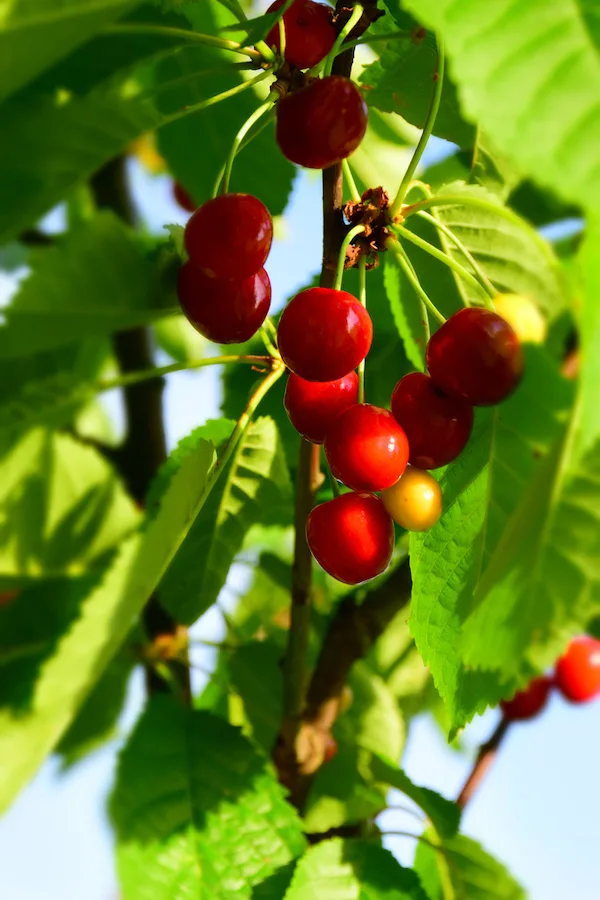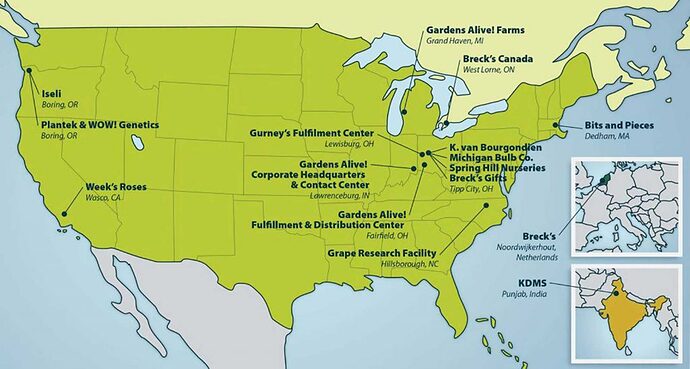My guess is they are an affiliate of the conglomerate gardens alive like gurneys and the Michigan bulb company Wowza!™ Dwarf Cherry | Michigan Bulb Company . The map below is what I know they are involved in but there could be more by now
Family of Brands - Gardens Alive
I had a first year Juliet Cherry in a container that didn’t survive the winter. Now, I have a four-year old Romeo cherry in a half wine barrel and a Montmorency that I planted last fall. Does anyone know if the Romance cherries and sour cherries will cross pollinate?
Yes one parent of the cross that makes up the romance cherry is North star. They will cross pollinate with sour cherries.
That makes complete sense. Thanks for the response, it’s appreciated.
This describes the earlier sibling to the romance series the carmine jewell.
The Carmine Jewel Cherry Tree - Minneopa Orchards
" The Carmine Jewel Cherry Tree
The Carmine Jewel cherry tree is a self-pollinating dwarf or bush cherry with small, tart-flavored fruit. Popular among gardeners, landscapers, and cherry enthusiasts. The fruit is renowned for its dark red color. The tree gives a heavy yield and is resistant to frost.

A cross between the prunus fruticosa (European dwarf cherry) and cerasus (sour cherry), the Carmine Jewel cherry tree is the perfect size for courtyards, urban lots, and indoor/outdoor containers. Just one of these dwarf cherry cultivars is generally sufficient for the average household. Plus, they take up far less space than alternative varieties.
During the spring, the Carmine’s white and pink blossoms will impress neighbors and delight your family. These exquisite blooms become delicious Carmine Jewel cherry fruits, renowned for their flavor and appearance. Local pollinators will love your cherry tree as much as you do as it becomes an integral part of your neighborhood ecosystem.
History of the Carmine Jewel Cherry Tree
The Carmine Jewel cherry treebegan as a cross between the sour cherry and European dwarf cherry. In the 1940s, Dr. Les Kerr interbred the two varieties at Morden Research Center. His work was later taken up by Dr. Stewart Nelson and Rick Sawatzky. In the 1970s and 80s, these two worked to produce a cultivar that had the best fruit and cold-resistance in a dwarfed size.
By 1985, the tree was nearing its true birth. Sawatzky continued the work with Dr. Cecil Stushnoff, now incorporating the Minnesota North Star cultivar into their crosses. These led to the 1999 production of the self-pollinating Carmine Jewel with its bigger, redder, sweeter fruit, all in a compact size.
Tree / Fruit Characteristics
There are numerous reasons why the Carmine Jewel dwarf cherry bush has ascended to such popularity. Its tasty fruit is famous for its sweet, tart flavor that exemplifies the classic dessert cherry. The wait time is quite short at only two or three years, making it a great pick for more eager gardeners. Plus, its stunning white and pink blossoms make up for the wait.
The Carmine Jewel grows much more like a large shrub than a classic cherry tree. Its glossy green foliage is a pointed oval shape with gently serrated edges. The tree’s compact size makes it a cinch to integrate it into your lawn or garden. This cultivar is extremely cold-hardy and relatively easy to grow.
Maintenance is simple and the bush gives a surprisingly high yield for its size. This all-around kind of cherry should be allowed to ripen to deep red. Leave it on the bush until fully ripe, as cherries do not ripen once picked. These sweet, mouth-puckering sour fruit will be ready to pick in July.
"
Yeah that’s what I thought.
Clark that’s interesting
If they’re dead ripe I can eat Juliet cherries fresh, but they’re still very sour. I wouldn’t eat more than a couple.
FWIW,
I have Juliet and Evan’s Bali. The Evan’s is a couple year older and Juliet was also moved 2.5 years ago. But as it stands Juliet is over 90% done blooming and Evan’s is near full bloom. So less than 10% overlap with these two varieties unless for some reason Juliet starts to bloom later as she gets older.
I have Juliet and Romeo. Both bloomed profusely this year, but the Romeo is much smaller. The J set quite a bit of fruit, but R I don’t think set hardly anything. J bloomed about 2-3 weeks before R.
I got a Carmine Jewel about an hour ago from HoneyBerry the buds seem to be kinda yellow in places, hopefully it survives, I put in a bucket of water, this is correct doing right?
Cherries don’t like standing water. The roots drown quicker than most other plants.
O shoot I’ll take it out, it was already about three hours
It will be OK that long but cherries are sensitive to water so I’m glad it wasn’t longer.
If the buds are yellow, unless it’s very obvious it was dried out, I’d lean towards it have a deficiency of light before a lack of water. In that case, it’s worth getting it water immediately as you did, but also exposing it to gentle grow lights indoors (any light will do to start, really), and then gentle morning sun a little more each day. You should be fine.
Yeah I tried to pack the tree with a bit on soil until tomorrow where I can plant it, there were these white bits in the roots any clue to what this could be, fertilizer? Should I apply copper at this point in time to try prevent future diseases like canker, I kinda already found a small spot that got me suspicious (we won’t talk about it), if I apply copper will it halt any further development of the pathogen if that’s it?
Would skip the copper for now. Once i see green I usually stop applying copper.
Do you think the spot would hold up till the winter, it’s like 2mm so not big deal
If your concerned I would consider spraying with captan. The romance series cherries are very resistant to canker. Ive not grown cupid, valentine or crimson passion so i dont know about those. This will help identify canker for those not familiar Kwanzan Cherry Canker | USU
" Kwanzan Cherry Canker
Q from Amy (received 5/20/20)
This is a Kwanzan cherry. What is going on here and how can I help it? This tree is usually a prolific bloomer, but this year it barely bloomed at all and the leaves are sparse. There are new leaf buds on the bare branches that are healthy.


A from Gabrielle Harden, USU Forestry Extension Educator (sent (5/21/20)
Amy,
It appears that this tree may have a canker. Unfortunately, with its location, there is not much you can do. If cankers occur on branches, the branches can be pruned to remove the canker. Here, the canker is on the bole. Cankers are caused by a variety of fungi, most commonly a fungus called Cytospora, but they can also be caused by bacteria. Your tree appears to have the fungal variety. The sap coming out is a condition referred to as gummosis - typically the result of another condition (cankers, insects, wounds, etc). Cankers are often the result of stressful conditions for a tree. It could have started as a frost crack and the fungi or bacteria got in. Trees are more susceptible when they are stressed or wounded. It is important to provide your tree with the proper environment (enough water, adequate sunlight, nutrients, minimal competition, etc.).
With the tree already being under stress, it is more susceptible to other pests such as insects. Reducing stress is vital to preventing further issues. Keep an eye on this area to make sure there are not insects getting in. If you see exit holes and frass, insects are in your tree and you have an entirely new issue.
To manage this there are some things you could try, but I fear this canker has gone too far. Once cankers are in the bole of the tree, there is little that can be done. 50% - 80% white latex paint mixed with Captan or Topsin OR Surround mixed with lime sulfur painted onto the area. Your best option is to ensure you are giving this tree enough water (drip irrigation often does not water deep enough, a tree needs to be deeply watered - 10 gallons per inch of diameter is a general rule of thumb) and continue to provide ideal living conditions. It is possible that once this tree gets enough water, the wound will start to heal and the tree will be just fine.
Here are a couple of resources that you may find helpful -
- https://utahpests.usu.edu/ipm/notes_ag/fruit-cytospora
- https://forestry.usu.edu/files/webinars/canker-disease-slideshow.pdf
I hope this helps.
Gabrielle Harden
"
Yeah that is for advice I feel like it’s a brown spot of wood/sub bark but it doesn’t seem to have anything else it looks to be mostly on the same level as the other bark, I think it’ll be fine but canker would develop quickly right I would know very soon?
I think it’ll be cloudy anyways I’ll just leave it outside
